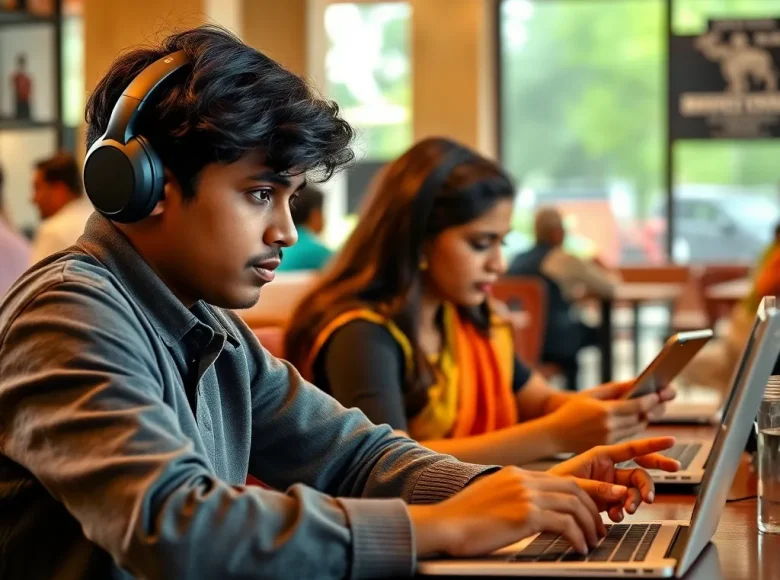Introduction
In India, where language is identity, regional languages are the heartbeats of communities. But in the digital world, much of the content is still mainly in English — leaving millions of regional language speakers underserved. Fortunately, Text-to-Speech (TTS) technologies are changing the narrative.
TTS enables written text to be converted into spoken voice, in multiple languages. When deployed for regional Indian languages, it becomes a powerful tool for bridging the accessibility gap. This article examines how TTS is making regional language content more accessible online, its significance, real-world applications, challenges, and how utilizing tools like Speakatoo can help you harness this power.

Why Regional Language Accessibility Matters
Cultural & Linguistic Diversity in India
India is home to 22 officially recognized languages and hundreds of dialects. People in Tamil Nadu, Maharashtra, West Bengal, Assam, Odisha, Gujarat, and more — many prefer consuming content in their mother tongue. When content is only in English or Hindi, vast segments of the population are left behind.
Digital Divide & Inclusion
Access to digital content should not be limited by language. For rural learners, less-educated users, and older generations, regional language content is far more meaningful. TTS brings written content to ears — enabling people to listen, understand, and engage when reading is a barrier.
Empowering the Visually Impaired & Dyslexic
Text can be a hurdle for people with visual impairments or reading disabilities. Regional-language TTS gives them access to books, news, educational materials, and websites in their own language — not just in English.
Boosting Regional Content Creation
When content creators see there is voice-read potential in regional languages, they are more inclined to produce local-language blogs, articles, and social media posts. It becomes viable to deliver audio-first experiences to a larger audience.
Key Benefits of Regional-Language TTS Online
Let’s break down the main advantages that make TTS a game-changer for regional-language content.

1. Improved Reach & Engagement
Audio content often has higher reach — people can listen while commuting, doing chores, or with limited literacy. Regional-language TTS means users won’t skip content just because it’s in text form.
3. Faster Content Consumption
Listening is often faster than reading, especially for long articles. A good TTS system allows your audience to consume content quickly, boosting retention.
2. Cost-effective Scalability
Instead of hiring voice-over actors for each regional language, creators can use TTS to scale audio versions of content with minimal cost. For each new article or blog, you can generate audio immediately.
4. Better Accessibility
TTS ensures that content isn’t exclusive. Whether it’s blogs, e-books, news portals, or educational platforms, adding a “play” button in local languages improves usability for all.
Regional-Language Use Cases: Who Gains from TTS
Education & eLearning
- Students can listen to textbooks or notes in Tamil, Marathi, Odia, or Assamese.
- Teachers can record lesson materials in local languages, making remote teaching inclusive.
- Podcasts and audio courses in regional languages widen access to learners in rural areas.
News & Media
- Regional news websites can publish audio versions of their articles.
- Local radio channels can re-purpose content for digital streaming in native languages.
- Journalists can transcribe interviews automatically and publish spoken segments.
Government & Public Communication
- Policies, notifications, and advisories can be issued in local language audio by government apps/websites.
- Disaster alerts in regional languages ensure everyone receives critical updates.
- Public health campaigns and civic messaging become more effective when available in local audio.
Business & Customer Engagement
- Local businesses, shops, and service providers can offer customer support and voice-based instructions in the local language.
- E-commerce platforms can provide audio descriptions of products in regional languages.
- Polling, surveys, user feedback can be collected via voice in native tongues.
Cultural & Literary Preservation
- Folk tales, poetry, and regional literature can be recorded through TTS and made available in audio libraries.
- Communities can preserve endangered dialects by converting written heritage into spoken archives.
How Speakatoo Text-to-Speech Helps with Regional Languages
Let’s focus on one tool that supports this mission: Speakatoo TTS. Below are features, advantages, and how to use it, tailored for regional-language content.
Key Features of Speakatoo for Regional Languages
Multilingual Support
Speakatoo supports a wide range of Indian languages: Hindi, Marathi, Tamil, Telugu, Bengali, Kannada, Malayalam, Gujarati, Punjabi, Odia, Assamese, Urdu, and more. This allows you to convert text into audio across major regional languages.Expressive & Natural Voices
The TTS voices are designed to sound human-like with natural inflections and modulation. This helps ensure the audio doesn’t sound robotic, especially for expressive regional content (poetry, storytelling).Adjustable Speed and Pitch
You can customize playback speed and pitch to suit your audience — slower for educational content, more energetic for marketing promos.High-Quality Audio Export
You can export in MP3 or WAV formats, making it easy to embed audio into websites, podcasts, or mobile apps.User-Friendly Interface
Even non-technical users can paste regional-language text and generate audio in minutes.Custom Pronunciations / Glossaries
For regional names, local place names, and dialectal vocabulary, you can specify pronunciations to improve accuracy.
How Speakatoo Text-to-Speech Helps with Regional Languages
Let’s focus on one tool that supports this mission: Speakatoo TTS. Below are features, advantages, and how to use it, tailored for regional-language content.
Key Features of Speakatoo for Regional Languages
Multilingual Support
Speakatoo supports a wide range of Indian languages: Hindi, Marathi, Tamil, Telugu, Bengali, Kannada, Malayalam, Gujarati, Punjabi, Odia, Assamese, Urdu, and more. This allows you to convert text into audio across major regional languages.Expressive & Natural Voices
The TTS voices are designed to sound human-like with natural inflections and modulation. This helps ensure the audio doesn’t sound robotic, especially for expressive regional content (poetry, storytelling).Adjustable Speed and Pitch
You can customize playback speed and pitch to suit your audience — slower for educational content, more energetic for marketing promos.High-Quality Audio Export
You can export in MP3 or WAV formats, making it easy to embed audio into websites, podcasts, or mobile apps.User-Friendly Interface
Even non-technical users can paste regional-language text and generate audio in minutes.Custom Pronunciations / Glossaries
For regional names, local place names, and dialectal vocabulary, you can specify pronunciations to improve accuracy.
Step-by-Step: How to Use Speakatoo for Regional Language Audio
Here’s a hands-on walkthrough:
Step 1: Go to Speakatoo TTS Portal
Open speakatoo.com in your browser. Choose the Text-to-Speech module.
Step 2: Select Regional Language
Pick the language you want (e.g. Tamil, Odia, Assamese) from the language drop-down menu.
Step 3: Paste or Type Your Text
Enter the regional-language text. Example: a blog paragraph in Marathi.
Step 4: (Optional) Choose Voice & Emotion
If choices exist, select male/female voice, and emotional tone such as “neutral,” “joyful,” “serious,” etc.
Step 5: Adjust Speed & Pitch
Tweak playback speed slower/higher or pitch slightly up/down to suit audience.
Step 6: Preview
Hit the “Play” button and listen. Make corrections if needed (fix mispronunciations, add punctuation).
Step 7: Export Audio
Download MP3 or WAV. You can embed this audio in your blog page or app.
Technical & Quality Considerations

When deploying regional-language TTS, consider these best practices:
- Punctuate properly — commas, full stops, and line breaks help TTS pause naturally.
- Avoid long run-on sentences — shorter phrases yield clearer audio.
- Use dialect-neutral vocabulary — regional slang may confuse AI.
- Test across devices — ensure audio quality remains clear on smartphones with low bitrate.
Trends & Future Directions
- Real-Time TTS: Live conversion of typed or regional language chat into spoken voice.
- Speech-to-Text-to-Speech (STT + TTS): Speak in one language, get audio in another.
- Voice Cloning in Regional Languages: Clone your voice and speak regional content in your voice.
- Localized AI Assistants: Virtual assistants that talk in Tamil, Bengali, Odia, etc.
- More Regional Voices: Expansion to smaller, endangered languages.
Frequently Asked Questions (FAQs)
Q1. What is Text-to-Speech (TTS) technology?
Answer: Text-to-Speech is a technology that converts written text into natural-sounding spoken audio. It allows users to listen to digital content in different voices and languages, making online information more accessible and engaging.
Q2. How does Text-to-Speech help with regional languages in India?
Answer: TTS makes content available in 12 major Indian languages like Hindi, Tamil, Telugu, Bengali, Marathi, Malayalam, Odia, Assamese, Gujarati, Punjabi, Kannada, and Urdu. It bridges the language gap, helps rural learners, supports visually impaired users, and increases reach for businesses and content creators.
Q3. Which is the best text-to-speech tool for Indian languages?
Answer: Speakatoo is one of the best text-to-speech tools for Indian languages. It supports multiple voices, natural speech, adjustable pitch/speed, and high-quality audio export in MP3/WAV formats. It is user-friendly, cost-effective, and works seamlessly online.
Q4. Can I use online text-to-speech tools for free?
Answer: Yes, many TTS platforms including Speakatoo offer free trials. However, for advanced features like unlimited usage, commercial rights, and higher-quality voices, a paid plan is recommended.
Q5. How accurate are online text-to-speech converters?
Answer: The accuracy depends on the platform and language support. Leading tools like Speakatoo provide 95%+ accurate pronunciation for most Indian languages, with natural inflection and clarity. Accuracy improves further when you use proper punctuation and clean input text.
Q6. Can TTS be used for commercial purposes like YouTube videos or podcasts?
Answer: Absolutely. You can use TTS-generated voices for content creation, e-learning, podcasts, YouTube narration, audiobooks, customer service, and more. Just make sure to choose a tool (like Speakatoo) that provides commercial usage rights under its plan.
Conclusion
The rise of Text-to-Speech in regional Indian languages is transforming the digital landscape. It is enabling accessibility, inclusion, and reach in a way no other technology has.
With tools like Speakatoo, creators, educators, businesses, and governments can deliver regional-language audio content effortlessly. As AI advances and more voices are added, the future is clear: regional language content will be heard, not just read.
If you’re looking for one of the best text to speech tools for regional languages, or you want to convert text to speech effectively in your audience’s mother tongue, try Speakatoo and take your content to the next level.
